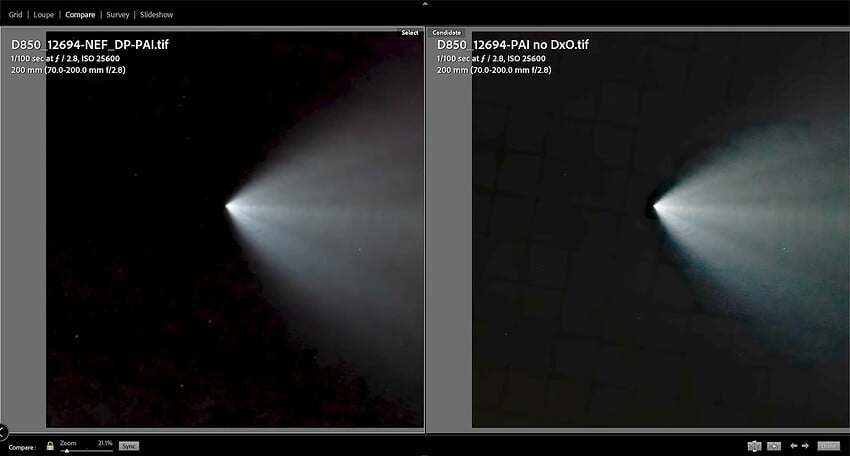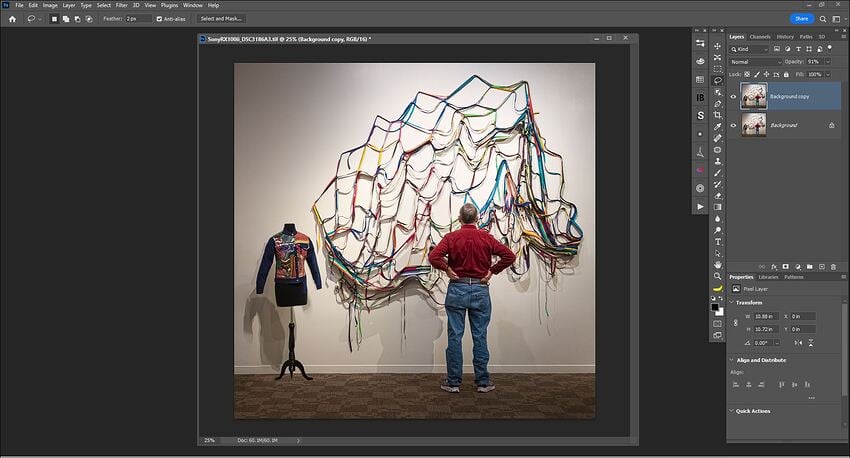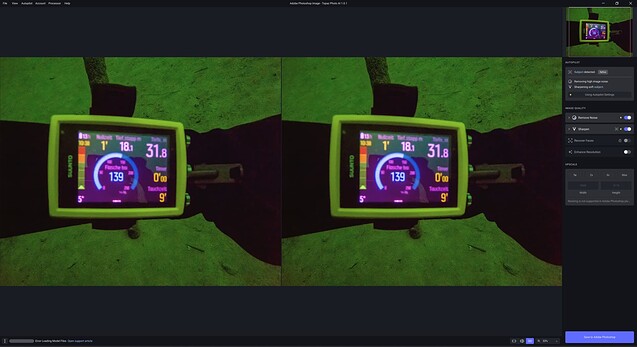Indeed, I don’t disagree.
This was an unexpected event so it was a quick grab on a Nikon D850, with Extremely high ISO (Auto) and there was no time to tweak settings as I ran in grabbed camera and grabbed the shot before the Falcon 9 rocket went out of view. This image received a first pass in DxO, followed by Lightroom adjustments and follow up in PAI and DAI with suggested settings. Other than choosing the best looking option from DeNoise AI no changes were made. While it may be hard to see in the lower res screen shot, DeNoise AI low light did a much better job of smoothing out the uneven areas of noise in the image. Again the stand alone product does a better job IMO. While the differences may be subtle, my feeling is, those of us using these products want the best performance/ quality, not a quicky solution.
The “Recover Faces” functionality is unnecessarily cumbersome if there is only one face. As it is, you have to figure out how to select the (only) face before you can turn face recovery on or off. And doing this is not particularly straightforward. Since there is only one face, the selection is unnecessary. Please require face selection only when there is more than one face.
A useful feature addition would be ‘add grain’ for photo Ai. Images can look too clean, the addition of some grain helps to give some texture to the skin for portraits. Essentially, the same feature in Sharpen ai.
Amen re: target mkt. Not my personal need/product desire.
At least how it is for now.
Which does still seem beta-ish.
I agree with both your post and @johnnystar post above.
The release thread for Topaz Photo AI has the subtitle “Autopilot for Image Quality,” so clearly the autopilot is the main focus of the application. The post consistently emphasizes the benefits of the autopilot automatically deciding on the settings and minimizing the amount of choices that the user manually has to make (of course the auto settings can be overridden if one chooses to).
The end result is an app that is targeted more towards casual users than “pros”—but given the state of the autopilot right now even the casuals may still need to make custom adjustments from time to time. The way that Photo AI’s user interface currently operates can make Autopilot a hindrance rather than a neutral feature or a help for these custom edits. And that’s unfortunate, since I think the idea of Autopilot is a good one, especially as the number of models and features increase.
You make a good point with the pricing. $150–$200 per year is steep, and while one can reduce the yearly price by not upgrading every year, it’s still a rather high cost. I think the competitive landscape where Topaz resides in comes from three different directions.
- More specialized AI software (this has been the case for a while).
- “Pro” image editors that cost money, such as Pixelmator Pro and its ML Super Resolution feature (I tried it a while ago and found it to be worse than Gigapixel).
- Default image editors such as Apple Photos. These are “free” and easy to use but lack advanced features.
I think Gigapixel AI and its siblings are currently somewhere between 1. and 2., while Photo AI seems to be philosophically moving towards 3. but with the price of 2. If the “pro” image editors become competitive with Topaz in terms of AI enhancements while the default editors become good enough for most people looking to “enhance” their photos, then in my opinion, Photo AI is at risk of being squeezed out by both of those segments.
Casual users tend to use smartphones to take photos, and their cameras have improved greatly over the past several years, not to mention the automatic software processing. In recent years, several phones have introduced periscope lenses and/or quad Bayer sensors which allow for higher resolution.
A 48 MP quad Bayer sensor is effectively a “2x scaling” over a regular 12 MP sensor. (It’s not as good as a “real” 48 MP camera but neither is AI upscaling.)
I have doubts that Apple will add upscaling to their Photos app in the near future—they want to sell shiny new 48 MP iPhone 14 Pros after all—but other enhancements are up for grabs. Currently Apple Photos’s sharpening and noise reduction leave a lot to be desired, but what if Apple makes a big improvement to them in a few years’ time?
So unless Topaz can continue to stay ahead of the competition with a strong focus on models, I can see many of its target audience having less reason to buy its apps in the future.
I agree. I want image enhancement that’s the best I can afford. For now, that’s the GAI/DAI/SAI suite of separate products.
It bothers me that ongoing development of those products may be deprecated.
Sadly, the more I use PAI, the more discouraged I become. I did a follow-up evaluation of the previously posted image without any preemptive noise reduction by DxO prior to processing with PAI. The Following is a comparison of the PAI image with prior treatment with DxO vs a PAI only treatment. Notice the grid pattern in the Image when edited by only PAI?
Contrast adjusted for visibility on web
Hello Engineers! My goal is to process raw DNG files (taken with a Leica Q2 monochrome) in PAI before I attempt any other exposure edits in Lightroom Classic. Regrettably, I still cannot open these raw files in PAI 1.0.1. I have mentioned this problem in this forum earlier.
These are large 87MB files taken with a 47 MP sensor. They won’t open in standalone mode nor as a plug-in for Lightroom. I can open them as TIFF copies, but that is not my intended workflow.
Perhaps I just won’t be able to use PAI in the way I have outlined. Please let me know if Topaz intends to address this shortcoming, or if it has chosen not to process larger raw files from Leica cameras.
Computer: iMac (late 2015 model with an intel chip)
OS: Monterey 12.6
Best of luck with the continuing efforts.
It does not for me. Tried with “open-close-open” and as Amin. Not working.
Works in all other Topaz programs…
What OS are you on?
PAI 1.0.1 Win 11, Ps 2022 (curr. rel.) Plugin. ARW original image (opened via Ps ACR into Ps).
Subject selected was the man and a small portion of one of the zippers hanging on the wall (in a quilts & textiles museum exhibition).
I’m experimenting with working primarily with the sliders - manually.
With this image, A.P. turned on denoising (which wasn’t particularly noticeable in the image. The setting set by A.P. was relatively low). A.P. didn’t turn on (or at least didn’t mention applying) sharpening (which the image really needed).
I left the denoising switch set to ‘on’. But I pulled the slider all the way to the zero position (far left of slider bar).
I expanded sharpening and pulled that slider up to about 1/3 position on the sharpening strength slider bar.
I was happier with the result (both denoising and level/quality of sharpening) by doing that manual setting than by accepting the A.P. settings. Takeaway: For me, a fully auto product wouldn’t cut it. It has different taste than I do (for better or for worse…).
Processed PAI image saved back to my Ps 2022 layer very slowly but otherwise w/out issue (it is not a large file; relatively - it’s from a 2013 Sony RX100 ii P&S cam - basically 3500 x 3200px image size, rounded). I reduced the opacity on that PAI layer by about 3% to hide any halo-ing around the sharpened zipper art edges but get the benefit of the other sharpening. I wasn’t about to start masking around all the zipper openings…
It seems there are many people here saying the results are less than good, in this case the image is a scan of an old printed photo and all settings are Auto Pilot … nothing less than amazing as you can see from this comparison. Although there is something that I would like to see and that is that hair is included in the face recovery as, in this case, the subject is correctly selected but you can see that the hair that falls in the face recovery confines is recovered nicely:
I am having the same issue. Version 1.0.1 will not install at all. The curious thing is that I use Avid Media Composer, and there are a number of AVX2 plugins in that program, and they all seem to work fine. The CPU, when I run dxdiag does not show AVX2 support.
Hi, I bought this software and I’m liking it very much!
The only problem, is that I have so much images (same size, type, style) to transform at once, but to do that, I have to configure each image individually.
It would be very interesting if an “batch” option is added to process hundreds of images at the same configuration.
Thanks in advance.
Windows 10
Raise a support request at the main website as it seems the problems may be with your computer. Support will be able to advise if there is an issue with dragging from the finder onto the open application as there are no issued with Windows 11.
I would prefer to have the ability to manually mask what I want the AI to enhance. I keep getting half the hair enhanced with the rest blurred out and I can’t use the image. It seems the AI can only do faces? It doesn’t seem to upscale much else.
I have the same issue - i have i5-2500k and RTX 3070 . And now i cant use anymore my 3070 after Photo AI update to v1.01 . This is really bad - please support Topaz team to fix it ! I wont change all my PC platform because of AVX2 compatible CPU …








